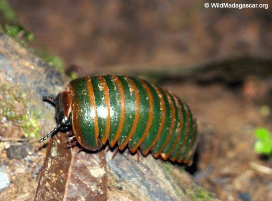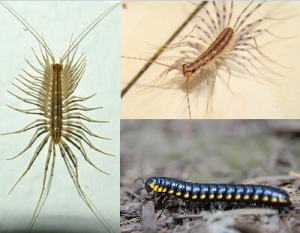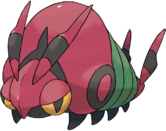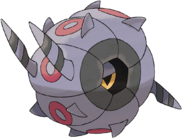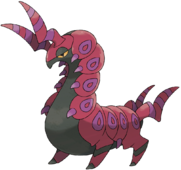Ayo! Mechanos here. This is my first article, quite a first for me overall! So now that the Jungle games are over, the real game begins, making content!
So as for the article, “Pokéology” is going to be a series focusing on the real-life, and zoological aspects of a Pokémon. That is, the basis, adaptions, behavior, habitat, as well as the diet! Each article will be split into spoiler-box segments, for your convenience. Expect to see it often, this will not be the only one, I promise.
This week, I’m focusing on the Venipede family; a unique little millipede/centipede line.
Basis (Here’s a quick warning to anyone with a phobia for centipedes –there are pictures!)
See that thing? You can probably tell where this is going; however, that’s no pill bug. Nope, that’s a millipede. This specific super-order of arthropods is known for its resemblance to a pill bug, and can be very easily mistaken for one. It’s likely this order was the main inspiration for Whirlipede’s strange nature, and does bear much resemblance to Venipede –see how Venipede has a large, circular back; one that gets bigger towards the small head? Yeah, that’s a trait of pill millipedes. It also explains the “feelers” on Venipede’s head, if you’ve ever watched a pill bug or millipede, they feel around with their antennae. However, this is not the sole basis, as millipedes are not commonly poisonous, as well as the distinct lack for any spines from their rear.
So we have two things up there, one you should know pretty well. The left and top parts show the House Centipede. I realize how many might say Scolipede is quite obviously based on a species of Scolopendra, a genus of centipede quite well-known. However, I don’t think this is entirely the case. Many Scolopendra species don’t quite fit the profile of Scolipede. I have a few reasons to say this –they tend to have no distinct patterns, speed, or visible eyes.
I have a few reasons for picking the House Centipede, specifically, the very obvious on the head, very visible eyes, striped legs/patterns, venomous/visible jaw, body shape, as well as the large stingers on the rear end. They are a type of centipede, however they are normally seen as the link between centipedes and insects, due to their compound eyes and other traits. See, the italic text stands out, doesn’t it? Remember Drapion? It could be seen as a bug type, however, it was put as poison/dark, not a bug type. Scolipede and its family could be seen as a bug type due to a resemblance, but I think it’s a bit more of a distinction. This also continues for the fact that house centipedes are the most common centipede in North America, with Unova being based on New York. They are everywhere, you probably have seen one in the last week. They’re also very fast, as you probably have also been reminded in the past week. But an interesting detail is their hunting strategy. They lie in wait until they find prey, not moving even at the most frightful predator, until prey crawls by. Then they pounce, latching their venomous jaws into the prey, paralyzing it, and then slowly chew on it. This matches most of Scolipede’s Pokédex with their lack of fear, their venomous jaws, and the fact they paralyze their prey while they chow down.
So how about that little black, yellow, and peaceful looking millipede that you’re probably dying to hear about after that description of chewing on a bug? That’s a yellow spotted millipede, a type of armored millipede with small yellow circles on its sides. It matches the hunched back, spots, and some of the body shape of Scolipede, and thusly I believe it was the inspiration for the other half of Whirlipede and Scolipede.
So that’s that, how about the Pokémon itself?
[/spoiler]
(There are no centipede pictures after that, I promise!)
Biology and zoology
So let’s take a close up look at each part of this little fellow.
The first thing that stands out is the colours and patterns, these seem to signal the venomous nature of the Pokémon, as well as very slightly camouflage the Pokémon from the air. Its Pokédex implies that bird Pokémon prey on it. The green and velvet colours would blend well in leaves, and would break up the shape from the air, making it look as if there are two different Venipedes, rather than one.
So let’s move on to the body parts. Venipede has four pairs of rudimentary legs that are not developed yet, and do not warrant much speed. Their single pair of small, half-closed eyes implies a lack of use for visual identification, and are most likely used to scan the distance for threats. This is backed up by their ‘feelers’ on the head and posterior side of the body, marked by the black stripes on each. These feel around it, most likely covering all directions, and are likely used to find edible prey. It is suggested that Venipede is brutally aggressive. This implies a predatory lifestyle, and thus it can be assumed the toxins found in Venipede are used for both defense and paralyzing prey. However, anything it paralyzes could be considered prey, as it can also be assumed to be opportunistic, eating anything it can.
Judging by the places it can be found, it most likely lives a lifestyle in the underbrush of forests, as well as tall, dark grass. It does not blend in well in fields, nor rivers not covered by canopies, and stays away from these.
How ’bout this crazy one? Ever wonder what advantages you’d have as a wheel?
When it evolved, it changed completely. It curled itself into a large wheel-shape, with its head and tail indistinguishable from the rest. Most likely the body has transformed into a single shape, rather than simply curling up. It keeps the same simple eye, but the rudimentary legs have adapted to balance its weight and add friction for it to roll across the dirt.
The feelers on the body have moved locations, most likely being used to increase speed. Rather than rolling simply like a tire, it most likely uses the feelers as a propeller, pushing itself across the dirt with them, each one moving in the same direction as they hit the ground, as well as each rudimentary leg doing this. Picture yourself in a spinning chair pushing off a table to keep spinning, and using your hand as soon as it comes around to continue the spin. That’s the principle that Whirlipede is using.
As for the colour, it appears to have camouflaged itself more for dusky conditions, as the Pokédex states that it does not move much. It can be considered as if it was a cocoon, which explains not only its sedentary nature, but also its distinct lack of a mouth. It most likely has found a place to hide in the dusky light under trees, and rests until it fully develops.
So last, and not least, Scolipede. Again, it has changed drastically, and finally turned into a full-fledged centipede, but it still shares many traits from its evolutionary roots.
The first thing you may notice is the massive feelers on its head now. These are most likely vestigial, that is, a part leftover from evolution. However, these are used not for feeling, but for attacking prey and aggressors. They are distinctly sharp, and can slice through most biological material. They may also be used for hierarchy in Scolipedes, and the larger they are, the more strength the Scolipede has.
Next, four of the rudimentary legs have fully developed, turning into the main propulsion of the species. The rest, however, have changed colour, and appear to be venomous. They assist the powerful, venomous jaws by latching into prey, and then injecting even more poison. Due to its aggressive nature, it can be assumed that anything it can poison will end up as prey.
It has ditched any attempt to camouflage itself, and is simply vivid purple and velvet. The spots, now bright, signify to any opponent that it is extremely venomous, and is to be taken seriously.
[/spoiler]
Comments? Favorite of the three? Suggestions for the next article? Drop into the discussion below! I’ll be sure to read.
Mechanos



